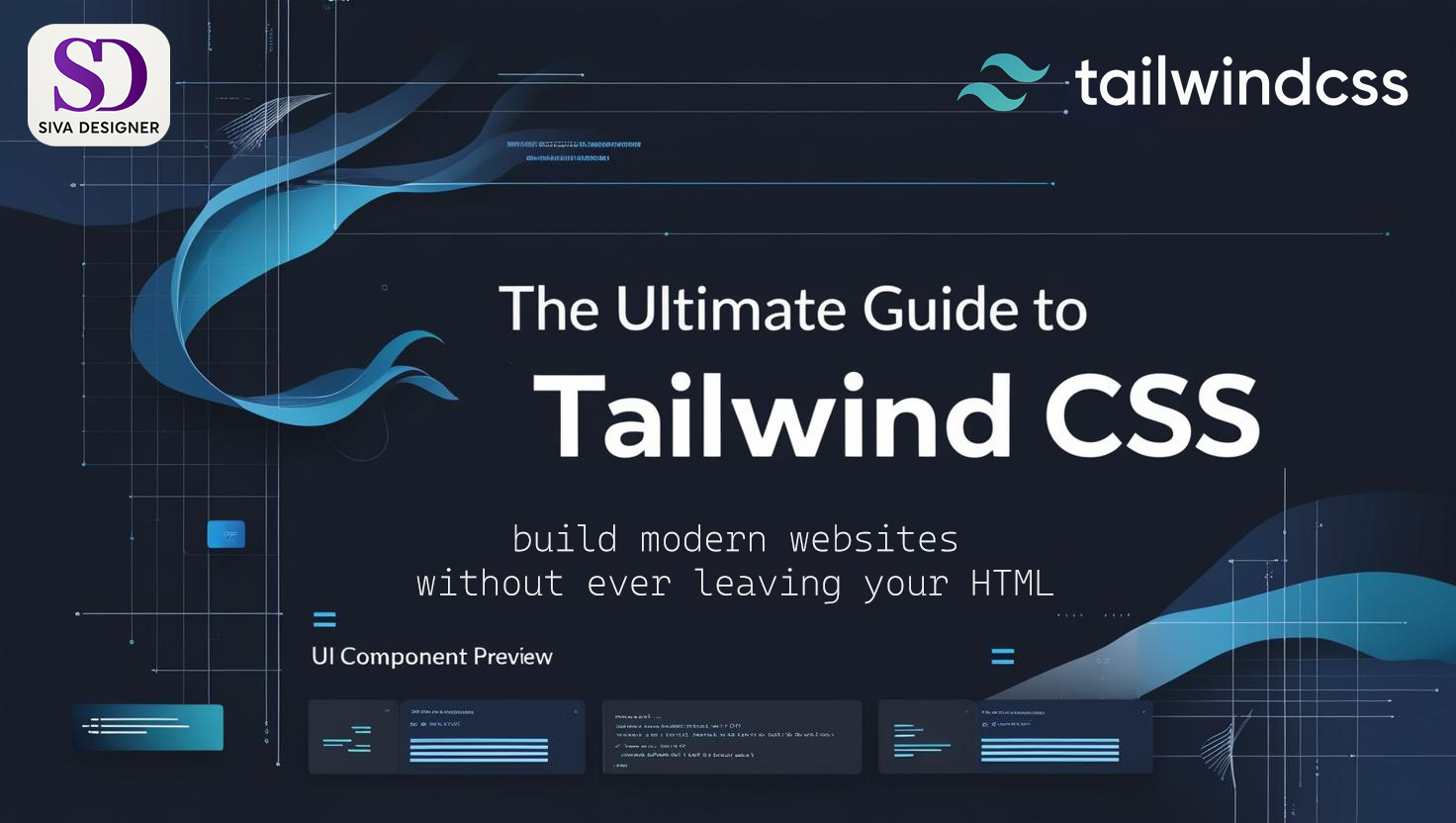
The Ultimate Tailwind CSS Guide in
Tailwind CSS is a utility-first framework that lets you design responsive interfaces directly in HTML. This 2025 guide shows how to install Tailwind (v3 & v4), master utilities, set up dark mode & theming, and ship lean CSS to production.
Unlike traditional frameworks like Bootstrap or Bulma , which rely on pre-built UI components, Tailwind CSS gives you low-level utility classes that you can combine to create completely custom designs without ever leaving your HTML.
What Is Tailwind CSS?
Tailwind CSS is a utility-first CSS framework packed with pre-defined classes that handle nearly every aspect of web styling : layout, spacing, typography, colors, borders, shadows, and more.
Instead of writing custom CSS rules, you simply apply these classes directly to your HTML elements.
Traditional CSS vs. Tailwind CSS
Traditional CSS approach:
Hello, World!
This is a sample text.
.card {
padding: 1rem;
background-color: #f9fafb;
border-radius: 0.5rem;
}
.title {
font-size: 1.25rem;
font-weight: bold;
margin-bottom: 0.5rem;
}
.content {
font-size: 1rem;
color: #6b7280;
}
Tailwind CSS approach:
Hello, World!
This is a sample text.
With Tailwind, you skip writing custom CSS altogether. Everything is handled inline, which means switching between HTML and CSS files.
Why Choose Tailwind CSS?
Tailwind CSS offers several advantages:
- Faster Development
- Consistent Design
- Consistent Design
- Built-In Responsive Design
- Lightweight in Production
You can style directly in your markup no need to flip between HTML and CSS files. This drastically cuts down on development time and makes iteration effortless.
Utility classes like p-4 or text-gray-600 ensure uniform spacing, colors, and typography throughout your project.
Tailwind is fully configurable. The tailwind.config.js file lets you customize everything—from colors and breakpoints to fonts and spacing scales.
Tailwind is mobile-first by design. Responsive utilities like md:bg-blue-500 or lg:text-2xl make building adaptive layouts intuitive.
Tailwind automatically removes unused styles in production using PurgeCSS , keeping your CSS bundle extremely small.
Getting Started with Tailwind CSS
There are multiple ways to use Tailwind via CDN, npm, or through frameworks like Next.js, Laravel, Angular, Sveltekit, Laravel or other frameworks.
Let’s walk through the npm setup, which gives you the most control.
How to install Tailwind CSS V4
Install tailwindcss and @tailwindcss/cli via npm.
npm install tailwindcss @tailwindcss/cli
Add the @import "tailwindcss"; import to your main CSS file.
@import "tailwindcss";
Run the CLI tool to scan your source files for classes and build your CSS.
npx @tailwindcss/cli -i ./src/input.css -o ./src/output.css --watch
Add your compiled CSS file to the <head> and start using Tailwind’s utility classes to style your content.
<!doctype html>
<html>
<head>
<meta charset="UTF-8">
<meta name="viewport" content="width=device-width, initial-scale=1.0">
<link href="./output.css" rel="stylesheet">
</head>
<body>
<h1 class="text-3xl font-bold underline">
Hello world!
</h1>
</body>
</html>
How to install Tailwind CSS V3
Install tailwindcss via npm, and create your tailwind.config.js file.
npm install -D tailwindcss@3
npx tailwindcss init
Add the paths to all of your template files in your tailwind.config.js file.
/** @type {import('tailwindcss').Config} */
export default {
content: ["./src/**/*.{html,js}"],
theme: {
extend: {},
},
plugins: [],
}
Add the @tailwind directives for each of Tailwind’s layers to your main CSS file.
@tailwind base;
@tailwind components;
@tailwind utilities;
Run the CLI tool to scan your template files for classes and build your CSS.
npx tailwindcss -i ./src/input.css -o ./src/output.css --watch
Add your compiled CSS file to the <head> and start using Tailwind’s utility classes to style your content.
<!doctype html>
<html>
<head>
<meta charset="UTF-8">
<meta name="viewport" content="width=device-width, initial-scale=1.0">
<link href="./output.css" rel="stylesheet">
</head>
<body>
<h1 class="text-3xl font-bold underline">
Hello world!
</h1>
</body>
</html>
A Deep Dive into Tailwind’s Utility Classes
Tailwind CSS is all about combining small, single-purpose classes to build complex interfaces. Let’s explore some common utility categories with examples.
Spacing (Padding & Margin)
Tailwind provides utility classes for controlling padding and margin. These classes follow a scale (e.g. pt-4, mt-2 ), where each number corresponds to a specific value in rem:
This element has padding and margin.
This element has padding and margin.
p-4mt-2mb-6
Adds padding of 1rem (16px).
Adds a top margin of 0.5rem (8px).
Adds a bottom margin of 1.5rem (24px).
Colors and Backgrounds
Tailwind offers an extensive color palette that you can use for text, backgrounds, borders, and more:
Welcome to Tailwind CSS Complete!
Welcome to Tailwind CSS!
bg-red-500text-whiterounded-lg
Applies a medium red background color.
Sets the text color to white.
Adds a large border-radius for rounded corners.
Typography
Tailwind’s typography utilities let you control font size, weight, line height, letter spacing, and more:
Tailwind gives you fine-grained control over typography.
Tailwind gives you fine-grained control over typography.
text-lgfont-semiboldleading-relaxedtracking-wide
Sets the font size to 1.125rem.
Applies a semi-bold font weight.
Adjusts line height for improved readability.
Increases letter spacing.
State Variants (Hover, Focus, Active, etc.)
Tailwind provides utility classes for different element states, such as hover:, focus:, and active:
hover:bg-green-700
Applies a dark green background-color on hover state.
Easy Animations and Transitions
Tailwind makes it simple to add smooth transitions and animations with pre-defined utility classes.

Flexbox and Grid
Tailwind excels at building responsive layouts with its Flexbox and Grid utilities:
Item 1
Item 2
Item 3
flexjustify-betweenitems-center
Enables Flexbox
Distributes space between child elements.
Aligns items vertically in the center.
Responsive design
With Tailwind’s responsive utilities, you can apply styles at different breakpoints:
This text scales with screen size.
text-smmd:text-lglg:text-2xl
Applies small text on mobile screens.
Increases text size at the `md` (768px) breakpoint.
Sets a larger text size at the `lg` (1024px) breakpoint.
How to customize Tailwind CSS V4
If you want to change things like your color palette, spacing scale, typography scale, or breakpoints, add your customizations using the @theme directive in your CSS:
@theme {
--font-display: "Satoshi", "sans-serif";
--breakpoint-3xl: 120rem;
--color-avocado-100: oklch(0.99 0 0);
--color-avocado-200: oklch(0.98 0.04 113.22);
--color-avocado-300: oklch(0.94 0.11 115.03);
--color-avocado-400: oklch(0.92 0.19 114.08);
--color-avocado-500: oklch(0.84 0.18 117.33);
--color-avocado-600: oklch(0.53 0.12 118.34);
--ease-fluid: cubic-bezier(0.3, 0, 0, 1);
--ease-snappy: cubic-bezier(0.2, 0, 0, 1);
/* ... */
}
Learn more about customizing your theme in the theme variables documentation.
You can also add custom styles to your tailwind projects.
How to customize Tailwind CSS V3
If you want to change things like your color palette, spacing scale, typography scale, or breakpoints, add your customizations to the theme section of your tailwind.config.js file:
/** @type {import('tailwindcss').Config} */
module.exports = {
theme: {
screens: {
sm: '480px',
md: '768px',
lg: '976px',
xl: '1440px',
},
colors: {
'blue': '#1fb6ff',
'pink': '#ff49db',
'orange': '#ff7849',
'green': '#13ce66',
'gray-dark': '#273444',
'gray': '#8492a6',
'gray-light': '#d3dce6',
},
fontFamily: {
sans: ['Graphik', 'sans-serif'],
serif: ['Merriweather', 'serif'],
},
extend: {
spacing: {
'128': '32rem',
'144': '36rem',
},
borderRadius: {
'4xl': '2rem',
}
}
}
}
Learn more about customizing your theme in the theme variables documentation.
You can also add custom styles to your tailwind projects.
Dark Mode Support
Tailwind includes a dark variant that lets you style your site differently when dark mode is enabled:
Light mode
Writes upside-down
The Zero Gravity Pen can be used to write in any orientation, including upside-down. It even works in outer space.
Dark mode
Writes upside-down
The Zero Gravity Pen can be used to write in any orientation, including upside-down. It even works in outer space.
Light mode
Writes upside-down
The Zero Gravity Pen can be used to write in any orientation, including upside-down. It even works in
outer space.
Dark mode
Writes upside-down
The Zero Gravity Pen can be used to write in any orientation, including upside-down. It even works in
outer space.
By default this uses the prefers-color-scheme CSS media feature, but you can also build sites that support toggling dark mode manually by overriding the dark variant.
Learn more about Tailwind dark mode support
Tailwind Plugins
Tailwind’s plugin system extends its functionality. For example, you can use the nira-ui plugin to get get pre-built ui components
npm install nira-ui
Use the @plugin directive to load a legacy JavaScript-based plugin:
@import "tailwindcss";
@plugin "nira-ui/plugin.js";
The @plugin directive accepts either a package name or a local path.
After Nira UI pulgin is installed, then you can use its components in your Tailwind projects.For example this is a default button out of the box:
Check out 9 Tailwind CSS Plugins that you should know about in .
Common Misconceptions About Tailwind CSS
- It’s Just Inline Styles on Steroids:
- Tailwind Bloats HTML with Too Many Classes:
- It’s Harder to Create Unique Designs:
While it may seem that Tailwind’s utility classes are similar to inline styles, they’re more powerful. Tailwind utilities are responsive, customizable, and reusable, allowing for much cleaner and maintainable code.
While Tailwind does involve adding more classes to your HTML, this trade-off provides better scalability, consistency, and control over your design. Additionally, you can use tools like `@apply` in your CSS or extract reusable components in your JavaScript framework (like React) to reduce repetition.
Tailwind is highly customizable. You’re not limited to default styles you can define your own color palettes, spacing scales, and more, allowing you to build completely unique designs.
Frequently Asked Questions (FAQ)
Tailwind CSS is a utility-first CSS framework that allows developers to write more concise and maintainable CSS code by providing pre-defined classes. It differs from traditional CSS frameworks like Bootstrap in that it doesn't come with pre-designed UI components, instead focusing on providing a set of utility classes to style elements.
You can install Tailwind CSS via NPM/Yarn by running the command `npm install tailwindcss` or `yarn add tailwindcss`, or use a CDN by including the Tailwind CSS link in your HTML file. You can also use a package manager like npm or yarn to install it.
The utility-first approach in Tailwind CSS means that instead of writing custom CSS code, you use pre-defined utility classes to style your HTML elements. This approach promotes a more efficient and maintainable way of writing CSS code.
Yes, Tailwind CSS can be used with popular frameworks like React, Vue, Angular, and Svelte. You can integrate it into your project by following the installation instructions for your specific framework.
You can create responsive designs with Tailwind CSS by using its breakpoint system and responsive modifiers, which allow you to apply different styles based on screen size.
You can create responsive designs with Tailwind CSS by using its breakpoint system and responsive modifiers, which allow you to apply different styles based on screen size.
Final Thoughts
Tailwind CSS isn’t just another framework it’s a modern way of thinking about design and development. Its utility-first approach empowers you to build fast, stay consistent, and customize everything to fit your brand or project.
Whether you’re a beginner crafting your first layout or a senior developer architecting scalable design systems, Tailwind CSS is a framework that grows with you.